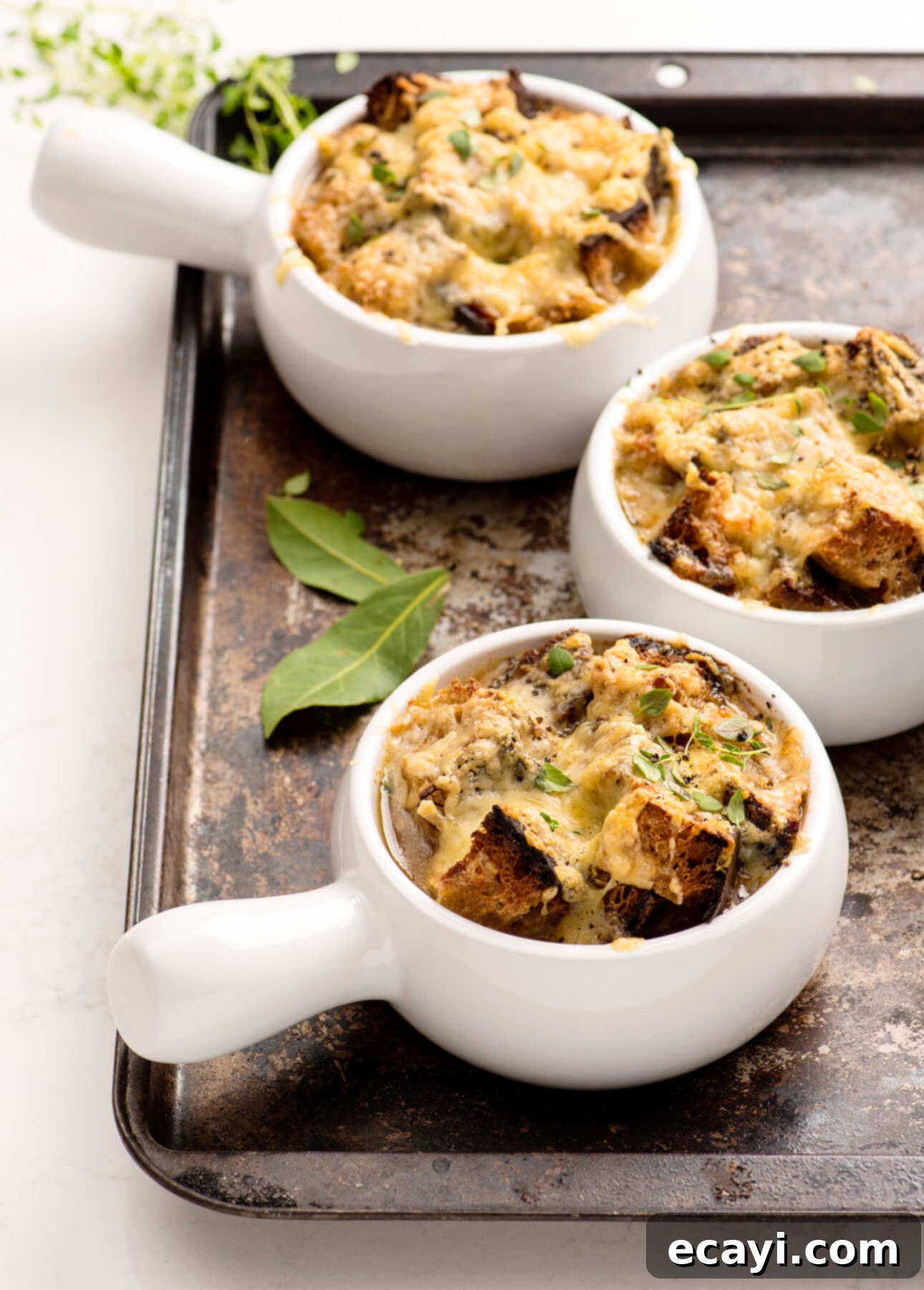Heartwarming Classic: The Ultimate Homemade French Onion Soup Recipe (with Vegan Options)
This French Onion Soup recipe reveals tips to make a heart-warming version of the classic comfort dish at home. Includes vegan variation.
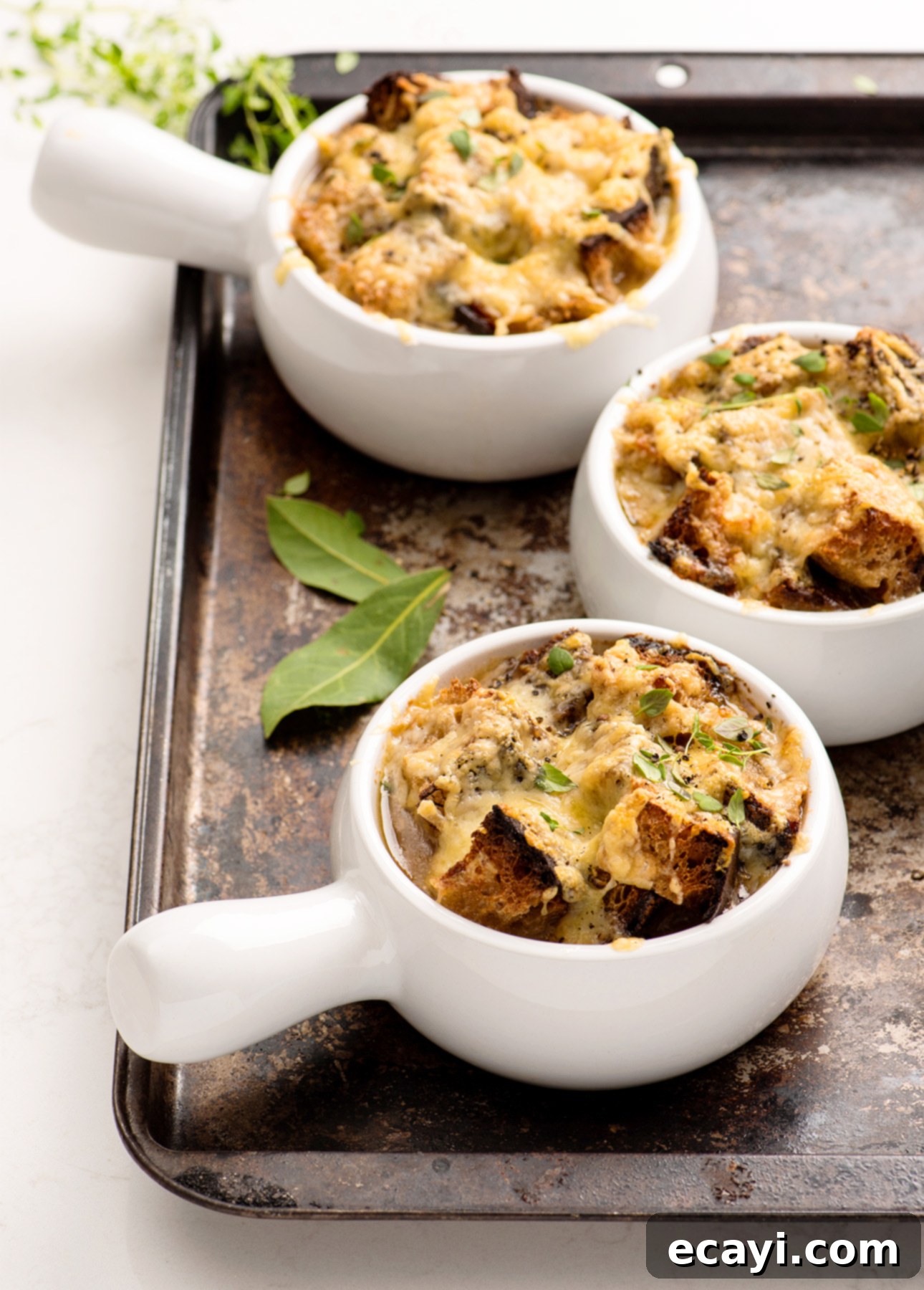
This post contains affiliate links. Full disclosure is at the bottom of the article.
Few dishes evoke the same sense of cozy comfort and culinary sophistication as a steaming bowl of French Onion Soup. Whether it’s warming you up after a brisk winter day, gracing the table during a romantic evening, or transporting you back to a charming Parisian bistro, this timeless classic holds a special place in the hearts of food lovers worldwide. Its deeply savory broth, infused with the sweetness of perfectly caramelized onions, topped with crusty bread and a generous blanket of melted, bubbly cheese, makes it an unrivaled champion of hearty and satisfying meals.
Indeed, French Onion Soup isn’t just a meal; it’s an experience. Each spoonful delivers a complex symphony of flavors – the subtle sweetness of the onions, the robust depth of the broth, the tangy crunch of the bread, and the rich, nutty notes of the melted cheese. It’s a dish that demands to be savored slowly, offering comfort and delight with every bite. Learning to create this iconic soup in your own kitchen is a rewarding culinary journey, and with the right techniques, you’ll be able to recreate that authentic bistro taste right at home.

The Enduring History of French Onion Soup
The concept of onion soup is far from a modern invention; humble onion-based broths have been nourishing people for hundreds of years. Onions, being readily available, affordable, and rich in nutrients, were a staple vegetable in many cultures. This made them an obvious and practical foundation for satisfying soups that were accessible to everyone, regardless of their economic status. For centuries, such onion soups were largely considered “peasant food,” a basic sustenance for the working classes, and were often overlooked by the upper echelons of society. However, this perception slowly began to shift.
One of the earliest documented recipes for a French onion soup, albeit a simpler version, appeared in an 18th-century cookbook under the name “soupe à l’oignon à la Paysanne” (peasant-style onion soup). It was a testament to the dish’s enduring appeal and nutritional value. The French Revolution, by dismantling class distinctions, inadvertently helped elevate many traditional peasant dishes, including onion soup, to a more celebrated status.
The rendition of French onion soup we recognize today—luxuriously topped with crisp croutons and a blanket of melted cheese—gained prominence in 18th-century Paris. Its birthplace was around Les Halles, the city’s bustling central market. This vibrant district, a hub of commerce and activity, offered a diverse culinary landscape. Market vendors, workers, and early morning revelers sought out hearty, affordable meals, and the soup, with its rich flavor and comforting warmth, fit the bill perfectly. It provided a much-needed energy boost and a delicious respite from the chilly Parisian mornings or late-night excursions. Soon, traditional restaurants surrounding Les Halles, such as La Poule au Pot, Chez Baratte, and the iconic Au Pied de Cochon, adopted the dish, refining it and cementing its status as a quintessential Parisian culinary experience. Remarkably, these establishments continue to serve their traditional French onion soup to this day, hundreds of years later, allowing diners to taste a piece of history.
French Onion Soup at the restaurant Au pied de cochon, in Paris (photo credit: Au pied de cochon)
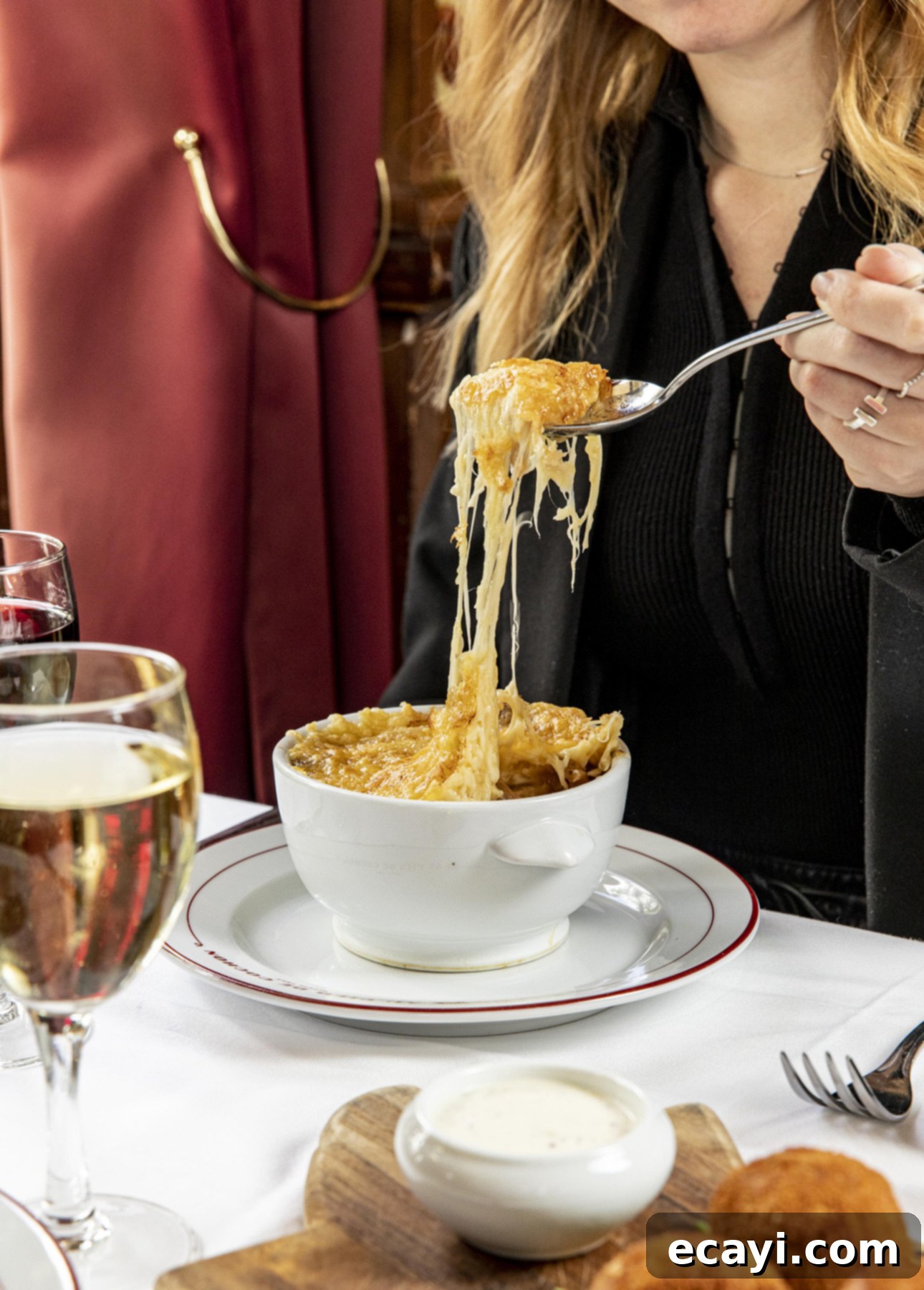
Mastering the Art of Homemade French Onion Soup
Creating a truly authentic and delicious classic French onion soup hinges on two fundamental steps: the meticulous caramelization of the onions and the slow, deliberate simmering of the soup base. While the entire process takes approximately two and a half hours, much of this time is hands-off, allowing for a surprisingly relaxed cooking experience.
The Crucial Caramelization: A Labor of Love
The first and arguably most critical step is the caramelization of the onions. This isn’t just about cooking them until soft; it’s a transformative process that builds the very foundation of the soup’s flavor. It’s where the raw, pungent onions morph into sweet, deeply flavored, and enticing morsels. Patience is paramount here; rushing this stage will compromise the entire dish. Just as you wouldn’t rush savoring a perfect bowl of French onion soup, you must allow the onions the time they need to develop their magic.
During the initial 30 minutes of cooking, the sliced onions will release their natural water content. This causes their volume to reduce significantly, and they become tender and translucent. Once this excess moisture has evaporated, the true caramelization process begins. This stage requires a low, consistent heat and regular stirring every 5 to 10 minutes. Stirring prevents the onions from sticking to the bottom of your pot and ensures they cook slowly and evenly, developing that desirable uniform color and tenderness. You’ll observe a gradual change: the onions will first turn a beautiful golden yellow, then deepen into a rich, inviting golden brown. This caramelization typically takes between 30 to 45 minutes, depending on your stovetop’s heat and the type of cooking vessel you’re using. The goal isn’t to burn them dark, but rather to achieve a soft, melty texture with a profound, concentrated sweetness.
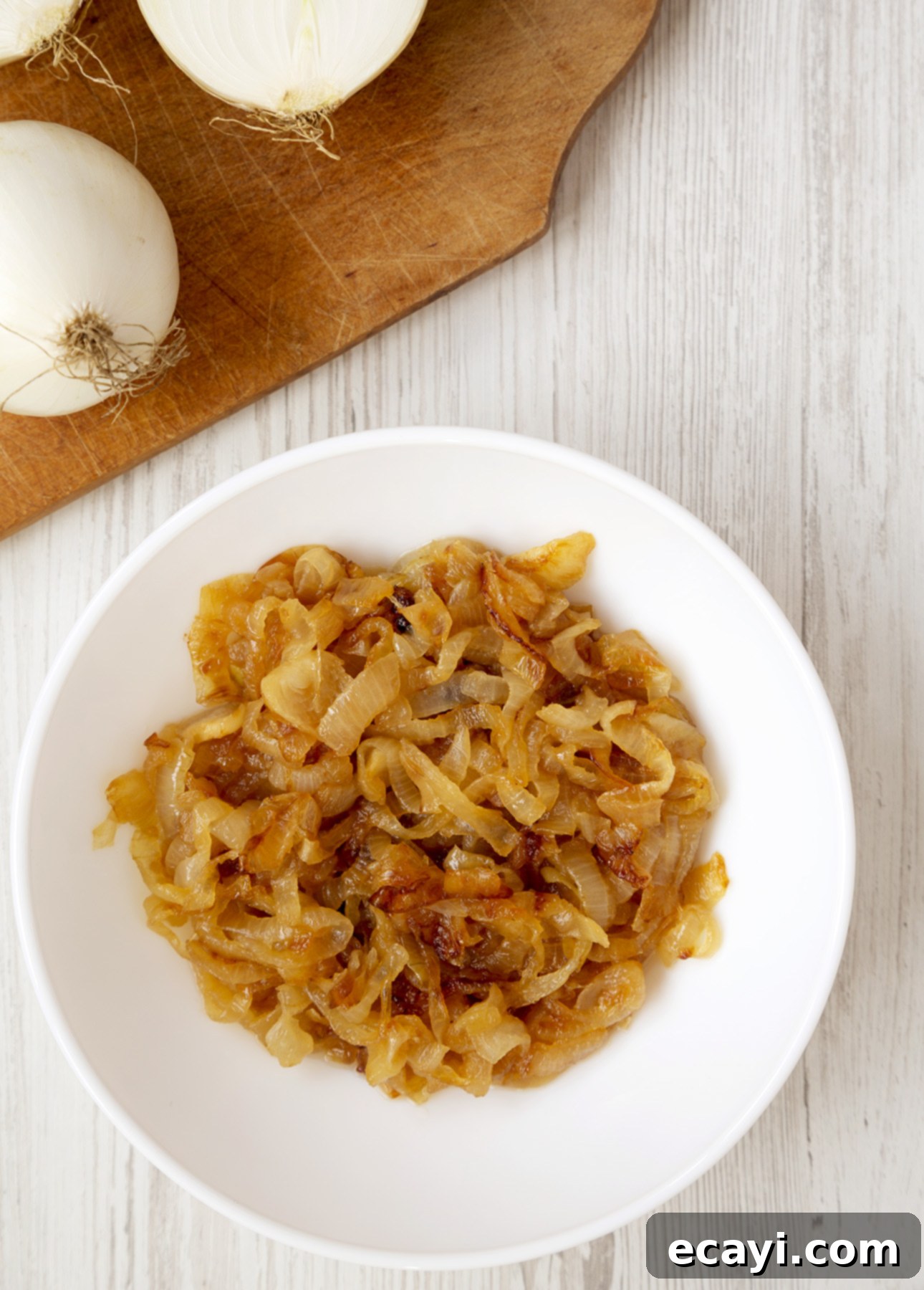
Simmering to Perfection: Blending the Flavors
Once the onions have reached their sweet, golden-brown perfection, the rest of the soup-making process is relatively straightforward. It’s simply a matter of stirring in the remaining ingredients, including your chosen liquid and seasonings, and allowing the soup to simmer for an additional hour. This extended simmering time is crucial for melding all the flavors together, allowing them to deepen and harmonize, creating that rich, complex broth that is characteristic of a great French onion soup.
The beauty of this recipe is that it yields a generous batch, making it perfect for meal prepping. French onion soup freezes wonderfully, so you can easily enjoy the fruits of your labor for future meals. Simply thaw, reheat, and top with fresh croutons and cheese for a quick and satisfying dinner.
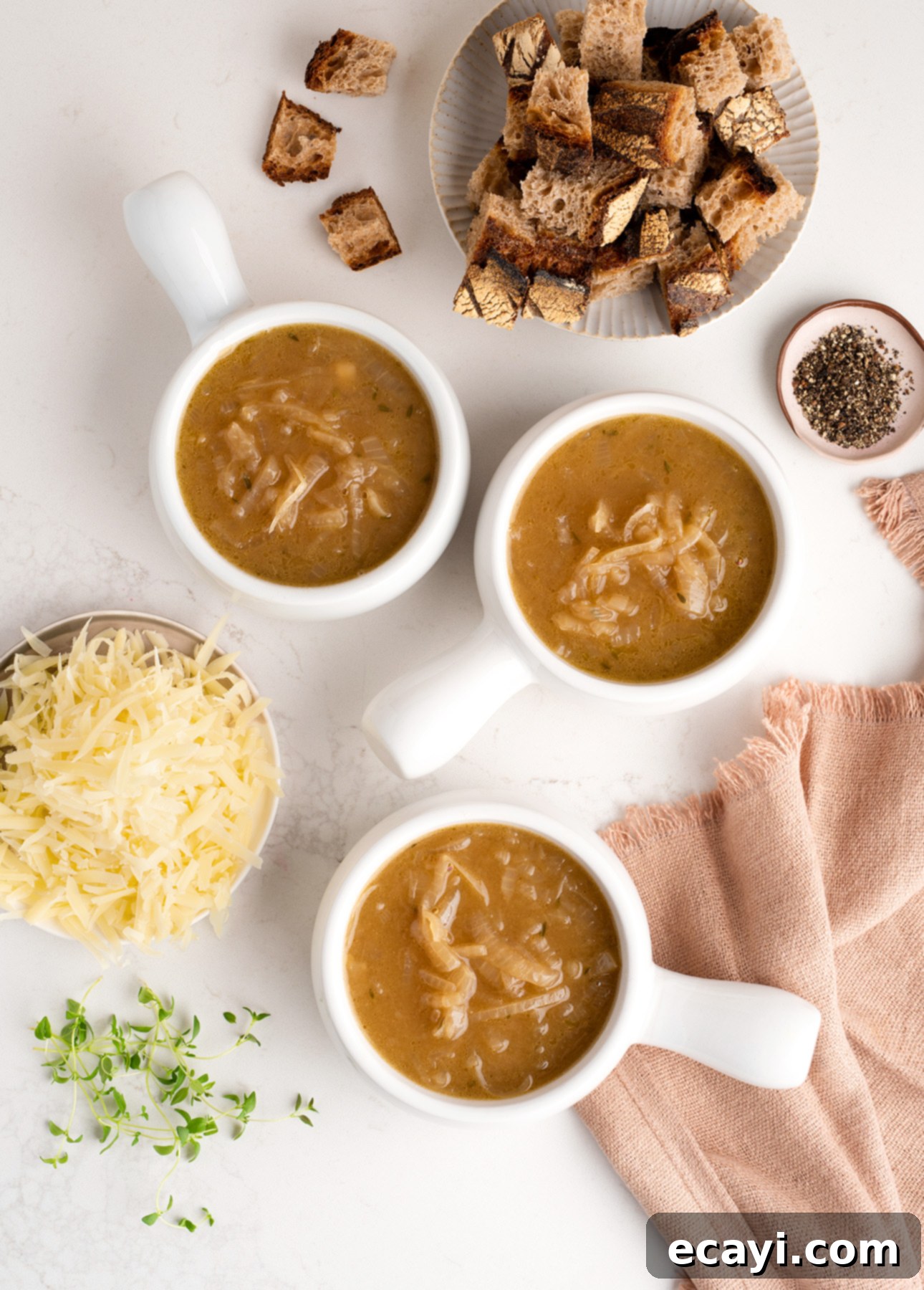
Essential Tips for Crafting the Best French Onion Soup
Elevate your homemade French onion soup with these expert tips, ensuring a consistently delicious result every time.
- Embrace a Variety of Onions: While large yellow onions (often called Spanish onions) are the traditional choice for their balanced flavor, experimenting with different varieties can add wonderful complexity. Red onions contribute a slightly milder, sweeter flavor and a beautiful hue. Sweet onions, such as Walla Walla or Vidalia, lack the sharp pungency of other types and introduce a delicate, natural sweetness to the soup. For a truly memorable bowl, try swapping in sweet onions for about one-third of the total quantity, or use a 50/50 mix of yellow and red onions. This blend will create layers of flavor that are truly exceptional.
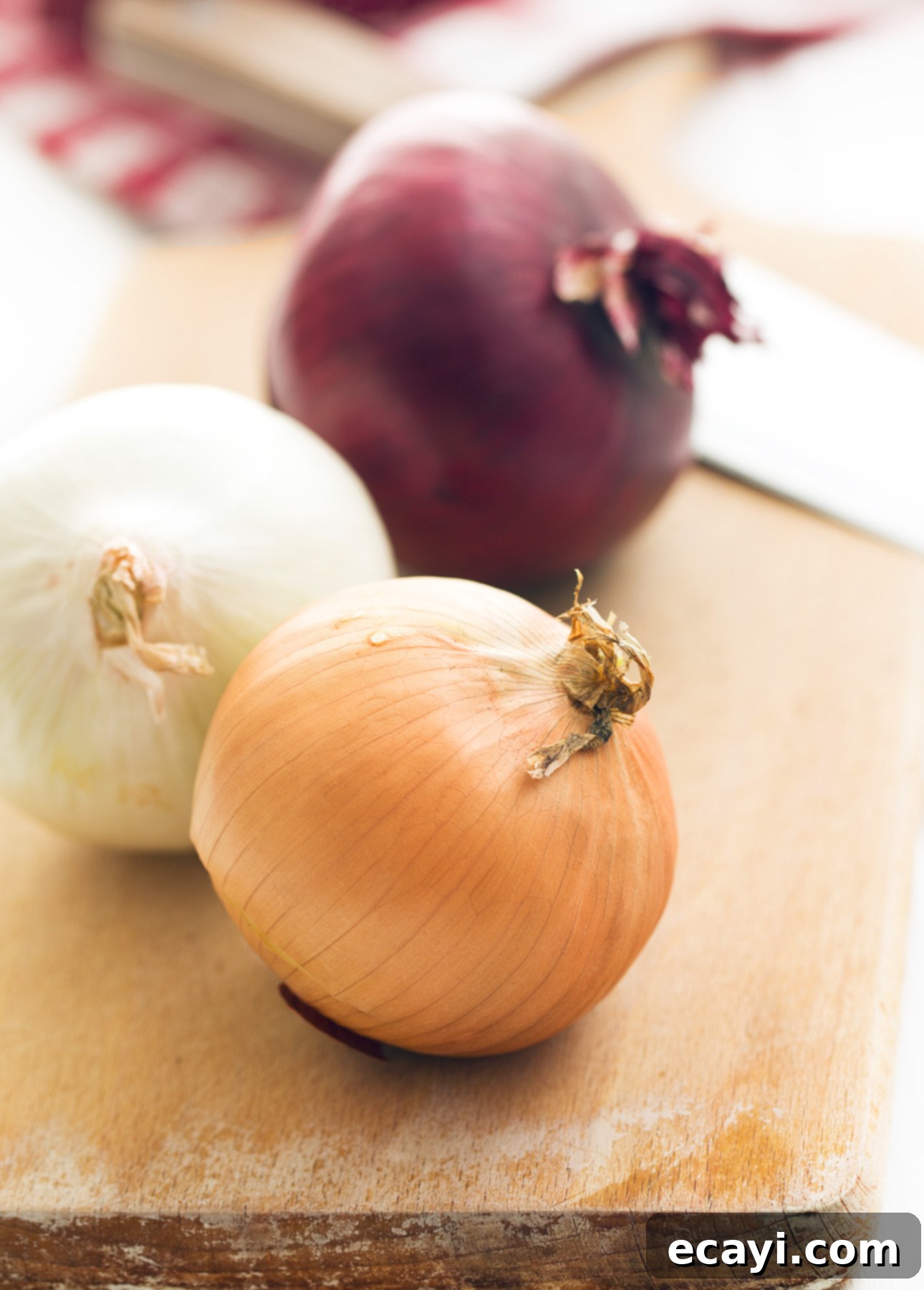
- Shield Your Eyes from Onion Fumes: For many, slicing onions is the most dreaded part of making this soup due to the tear-inducing chemicals. Rest assured, there are effective ways to minimize the burning sensation and tears. The culprits are sulfur compounds that are released when onion cells are cut.
- Chill Them Out: Refrigerating onions for about 30 minutes before slicing can significantly reduce the amount of irritant chemicals released, as cold temperatures slow down their dispersion. Slice them immediately after taking them out of the fridge. (Note: avoid storing onions in the fridge long-term, as the moisture can accelerate spoilage.)
- A Sharp Knife is Your Friend: A very sharp knife makes clean cuts, minimizing cell damage and, consequently, reducing the release of those irritating compounds.
- Utilize Ventilation: If your kitchen setup allows, position your cutting board near the stove and turn on your range hood to its highest setting. The fan will draw away most of the chemical irritants, keeping them away from your eyes.
- Gear Up with Goggles: This might sound unconventional, but wearing protective eyewear, like ski goggles or even specially designed “onion goggles,” is incredibly effective. For those who wear contact lenses, you’re in luck; the lenses often provide a barrier against the irritants, offering natural protection.
- Experiment with Broth Enhancers: Traditionally, cognac, brandy, or even cider are used to deglaze the pan and add depth. A dry white wine is an excellent choice for balancing the sweetness of the onions and enhancing the overall flavor profile without adding excessive sweetness. Fortified wines such as Madeira, sherry, or port can also introduce rich, complex notes. For a bolder twist, consider a full-bodied red wine or even a dark beer. The alcohol content fully evaporates during the simmering process, leaving behind only the delicious flavors, making the soup perfectly safe for children. If you prefer to omit alcohol entirely, simply substitute it with an equal amount of additional chicken, beef, or vegetable stock.
- Select the Perfect Cheese: The choice of cheese is crucial for that iconic gooey, flavorful topping. Opt for sharp, robustly flavored varieties that melt well. Aged Comté is a favorite for its nutty, complex notes. Other excellent choices include Gruyère, renowned for its excellent melting properties and rich flavor, Swiss cheese, mild Emmenthal, or a sharp aged Cheddar. The goal is a cheese that forms a beautiful, golden-brown crust and pulls deliciously when served.
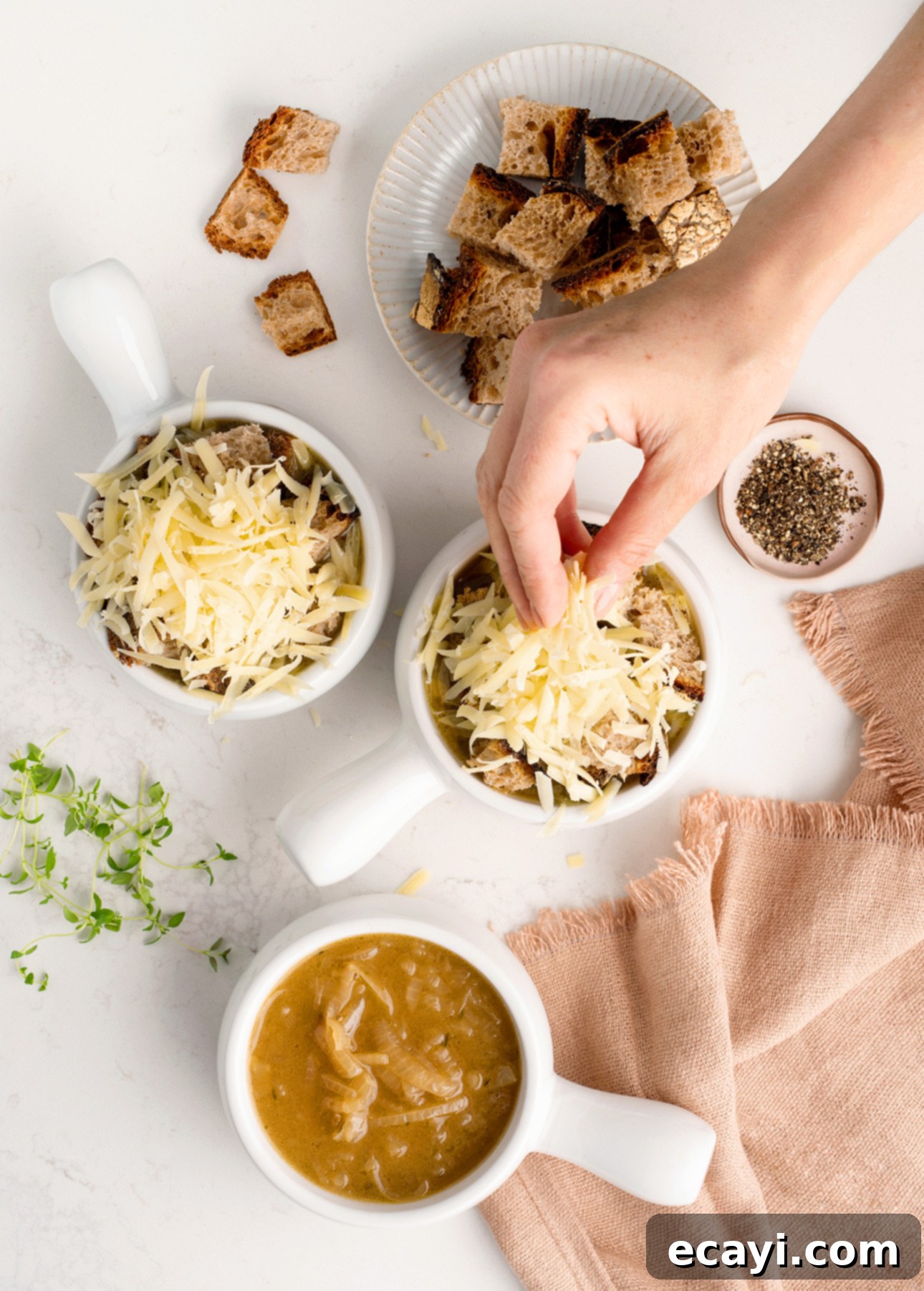
- Toast Your Bread Cubes for Superior Texture: The bread used for topping French onion soup should be sturdy and crusty to withstand the broth without becoming soggy too quickly. While slices of bread are common, cutting the bread into large cubes offers a distinct advantage: it makes it much easier to scoop out perfect, cheesy bites without struggling with a soggy, submerged slice. To elevate the experience even further, toast these bread cubes on a baking sheet before distributing them over individual servings. This simple step makes them sturdier and ensures they maintain their delightful shape and satisfying texture even after a quick broil under the cheese.
Deliciously Vegan French Onion Soup
French onion soup is inherently close to being a vegan dish, requiring only a few simple substitutions to make it completely plant-based without sacrificing any of its rich, comforting flavor.
- Fat Swap: Instead of butter, use extra-virgin olive oil for caramelizing the onions. Vegan butter is another excellent alternative, providing a similar richness and flavor profile.
- Broth Choice: Simply substitute chicken or beef stock with a high-quality vegetable stock. Look for a robust, flavorful vegetable stock to ensure a deep and satisfying broth.
- Cheesy Topping: The market for vegan cheeses has expanded dramatically, offering fantastic options for topping your soup. Use a combination of shredded vegan cheeses for the best results. For example, Daiya’s Mozzarella Style Shreds offer excellent meltiness, while Follow Your Heart’s Vegan Parmesan Shredded Cheese Alternative can provide that boost of salty, savory flavor essential to the dish.

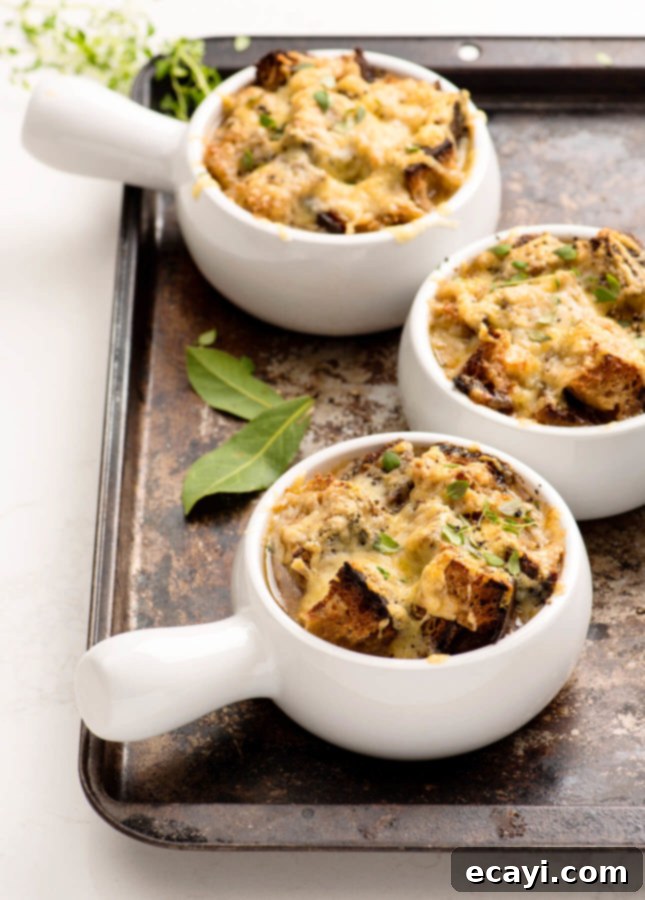
Pin Recipe
Classic French Onion Soup
Ingredients
For the French onion soup
- 2 tbsp extra-virgin olive oil, or a neutral tasting oil (canola, sunflower, grapeseed)
- 2 tbsp butter
- 4½ lb onions—yellow, red, sweet, or a combination—peeled and sliced into ¼ inch (6 mm) half circles
- ½ tsp kosher salt, or fine sea salt
- ½ cup dry white wine, cider, amber or dark beer, or full-bodied red wine, or ¼ cup (60 ml) cognac, brandy, or fortified wine, such as Madeira, Sherry, or Port (if you don’t want to use alcohol, substitute ½ cup/125 ml extra chicken or beef stock)
- 2 tbsp all-purpose flour
- 8 cups chicken or beef stock
- 2 tsp Dijon mustard
- 1 tsp dried thyme, or 4 sprigs of fresh thyme
- Freshly ground black pepper
To serve
- Crusty day-old bread or baguette, preferably sourdough, cut into large cubes—about ½ cup/125 ml per serving
- Grated aged cheese, such as Comté, Gruyère, Emmenthal, Swiss, or Old Cheddar Cheese—a generous ¼ cup/60 ml per serving
Instructions
-
Place a large stockpot or Dutch oven over medium-low heat. Melt the butter into the oil. Add the onions, sprinkle with the salt, and stir to coat with the butter and oil mixture. Cook the onions, stirring thoroughly using a wooden spoon every 5 to 10 minutes, for a total of about 1 hour, or until the onions and melty, sweet, and golden brown.
-
Pour the wine over the onions, then scrape the bottom of the pan to deglaze. Let the liquid evaporate almost completely, then sprinkle with the flour and stir to incorporate. Add the stock, mustard, and thyme (if using fresh thyme, no need to pick the leaves from the stems—simply add the whole sprigs to the pot). Stir to combine and season with black pepper. Increase the heat to bring the soup to a simmer. Half-cover, then lower the heat to keep the soup at a steady simmer. Cook for 45 minutes, stirring every 15 minutes. Taste the soup and add more salt if needed. Fish out the sprigs of fresh thyme, if needed.
-
SERVING: Set a rack in the middle position of the oven and turn the oven broiler on. (Setting the rack too close to the broiler will burn the bread and cheese too quickly.) Spread the bread cubes over a baking sheet. Toast for 2 minutes, then stir the cubes and return to toast for an additional 2 minutes (make sure to keep a close eye on the bread cubes to prevent them from burning.) Remove from the oven and set aside.
-
Place oven-proof bowls or crocks over a baking sheet then fill 3/4 of the way up with soup. Top each serving with about 1/2 cup (125 ml) toasted bread cubes and 1/4 cup (60 ml) shredded cheese. Transfer to the oven and broil until the cheese is melted, golden brown, and bubbly. Carefully transfer each bowl to a serving plate (the bowls are piping hot so setting them on a cool plate makes them easier to handle). Serve immediately.
-
STORAGE: Let the French onion soup cool to room temperature. Store in portions in airtight containers. Refrigerate for up to 3 days or freeze for up to 3 months.
-
HOW TO MAKE VEGAN FRENCH ONION SOUP: Substitute oil for the butter. Use vegetable stock instead of chicken or beef stock. Top the soup with a combination of shredded vegan cheeses, such as Daiya’s Mozzarella Style Shreds for meltiness combined with Follow Your Heart’s Vegan Parmesan Shredded Cheese Alternative for flavor.
Did you make this?
Tell me how you liked it! Leave a comment or take a picture and tag it with @foodnouveau on Instagram.
Creating this classic French onion soup at home is a rewarding endeavor that brings a taste of French culinary tradition right to your kitchen. With its rich history, deep flavors, and comforting warmth, it’s a dish that truly stands the test of time. Whether you opt for the traditional version or the equally delicious vegan alternative, you’re guaranteed a meal that will impress and satisfy. Enjoy the process, savor the aroma, and delight in every spoonful of this truly magnificent soup.
This site participates in the Amazon Associates Program, an affiliate advertising program designed to provide a means for the site to earn fees by linking to Amazon and affiliated sites.
If you click on an affiliate link, I may earn advertising or referral fees if you make a purchase through such links, at no extra cost to you. This helps me create new content for the blog–so thank you! Learn more about advertising on this site by reading my Disclosure Policy.
